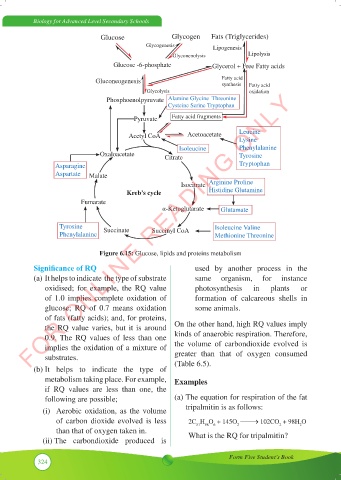Page 331 - Biology_F5
P. 331
Biology for Advanced Level Secondary Schools
Glucose Glycogen Fats (Triglycerides)
Glycogenesis Lipogenesis
Glyconenolysis Lipolysis
Glucose -6-phosphate Glycerol + Free Fatty acids
Gluconeogenesis Fatty acid Fatty acid
synthesis
FOR ONLINE READING ONLY
Glycolysis oxidation
Phosphoenolpyruvate Alamine Glycine Threonine
Cysteine Serine Tryptophan
Pyruvate Fatty acid fragments
Acetyl CoA Acetoacetate Leucine
Lysine
Isoleucine Phenylalanine
Oxaloacetate Citrate Tyrosine
Asparagine Tryptophan
Aspartate Malate
Isocitrate Arginine Proline
Kreb’s cycle Histidine Glutamine
Fumarate
α-Ketoglutarate Glutamate
Tyrosine Succinate Isoleucine Valine
Phenylalanine Succinyl CoA Methionine Threonine
Figure 6.15: Glucose, lipids and proteins metabolism
Significance of RQ used by another process in the
(a) It helps to indicate the type of substrate same organism, for instance
oxidised; for example, the RQ value photosynthesis in plants or
of 1.0 implies complete oxidation of formation of calcareous shells in
glucose; RQ of 0.7 means oxidation some animals.
of fats (fatty acids); and, for proteins,
the RQ value varies, but it is around On the other hand, high RQ values imply
0.9. The RQ values of less than one kinds of anaerobic respiration. Therefore,
implies the oxidation of a mixture of the volume of carbondioxide evolved is
substrates. greater than that of oxygen consumed
(b) It helps to indicate the type of (Table 6.5).
metabolism taking place. For example, Examples
if RQ values are less than one, the
following are possible; (a) The equation for respiration of the fat
(i) Aerobic oxidation, as the volume tripalmitin is as follows:
of carbon dioxide evolved is less 2C H O + 145O ⎯ →⎯ 102CO + 98H O
6
2
98
2
2
51
than that of oxygen taken in. What is the RQ for tripalmitin?
(ii) The carbondioxide produced is
Form Five Student’s Book
324

